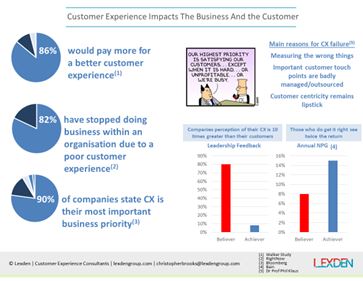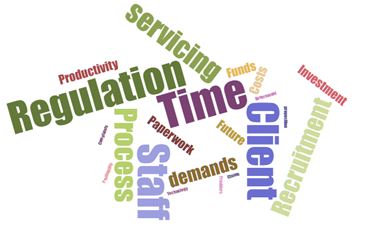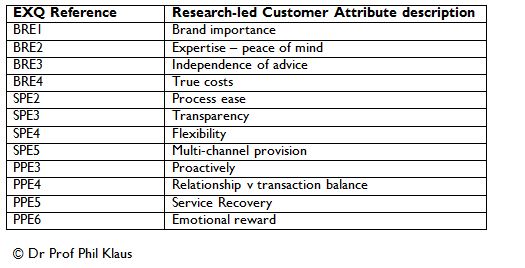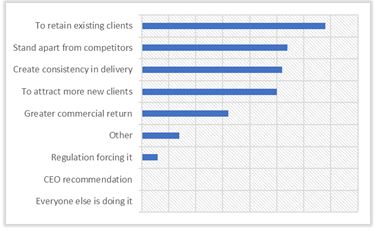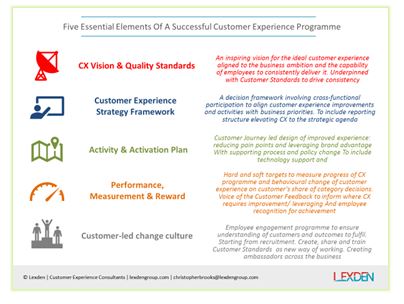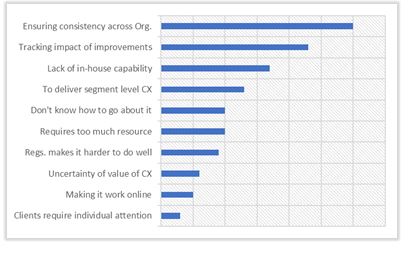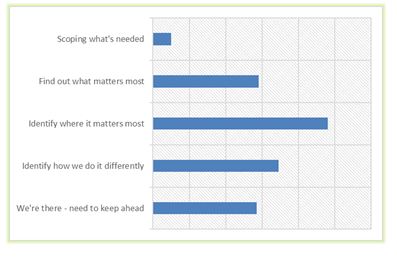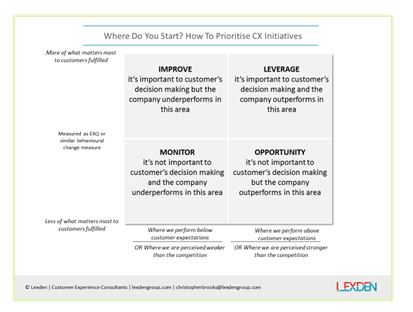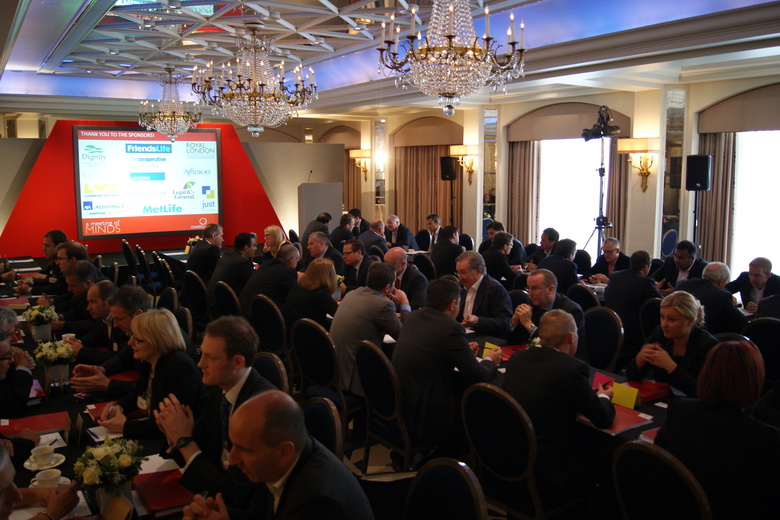


Expert: Christopher Brooks, Lexden
Facilitator: James Goad, Owen James Group
The case for customer experience grows across many sectors with 90% of sectors stating it was their most important focus for 2017. Organisations with tiers of staff between the end customer and the strategic business decision makers have embraced customer experience as a way of reconnecting with the customer to ensure the way they deliver and manage their products and services fulfil customer requirements effectively.
However, for organisations where the principal stakeholders are often those also engaging with the end clients or customers what is the value of customer experience? Speaking with over thirty representatives from such small to medium sized financial advisory firms at Owen James’ Meeting of Minds conference in Leeds in April 2017; we understood why they felt there was value in customer experience and where they are on their journey.
Taking a step back, what is customer experience? This definition resonated well with the group, who accepted the breadth and all-encompassing nature of ‘CX’ make it feel daunting to the uninitiated.
Customer Experience is the entirety of the interactions a customer has with a company and its products or services.
Customer Experience defines the perceived match between the value of a company’s offerings on the one side and the customer’s personal values on the other side.
Views vary regarding the potential of CX (results are presented as an aggregated view from both groups):
Creating Consistency | Deliver the right level of service | Adding extra value | Understanding what the right experience clients expect | Simplifying what’s delivered | Creating a differentiator | Understanding whether what we currently deliver is right for our customers? | Be ahead of the curve | Grow the business | Fine Tuning client offering | Formalising what comes second nature
Customer Experience has evolved from a focus on customer at all cost, to understanding the commercial advantage of putting customers central in all decision making, as the following stats show.
When asked what featured high on the adviser’s list of business challenges, reassuringly client servicing and client satisfaction featured highly. However, with ‘time’ the greatest challenge, allocating extra time to develop a successful customer experience approach may prove a stretch for many. Ironically, effective Customer Experience may reveal that advisers spend time on activities which their clients are satisfied with but make no impact on their decisions to remain and trust one adviser with their financial affairs over another. The result of which would mean more time for the adviser to focus on Customer Experience.
What are your biggest business challenges?
We asked what ‘customer experience’ activities advisers were engaged with and what they delivered which they felt was a fine example of their CX. Many of these are worthy and should form part of a cohesive CX programme, whilst some fall in to the ‘wow’ category. Wow and ‘delight’ experience can often be costly, with customers happy to receive them but revealing in research they do not change their behaviour positively, which means the deliver a negative ROI.
Without understanding the context of the competitive environment or the impact (in terms of incremental business) these generate, any ideas should be taken forward in isolation with caution. CX best practice sharing should ideally be accompanied with an appropriate commercial business case. Here are some of the ideas shared:
- Invite to seminars – bring a friend
- Newsletter with new tax information etc.
- Quick personalised response
- Food for clients if they have travelled far
- Car valet whilst client has appointment
- Treat every client as an individual
- Questionnaires to capture views on process
- Annual review
- Responsive to requests

Applying this understanding into the business provides a platform to align decision making to the behaviours which create more business for the company. Which ties in very well with the key motives for customer experience detailed below.
The 25 drivers are readily available in Prof Dr Phil Klaus’ top three Amazon business book. At Lexden we convert the academic language into business sense and identify what these activities look like in your business. We then work with the output of studies commissioned on your clients using EXQ to create a workable set of unique Customer Standards, which if applied ensure the whole business is focussing on what drives profit from customer.
Below is a sample of the typical drivers. These each have a weighting of importance which varies by organisation and their clients. The EXQ model calculates this by comparing it to 1,000 other organisations. These drivers are also grouped by three areas of impact (Brand Experience, Service Experience and Post-Purchase Experience), which in turn have a weighting impacting the overall score.
When asked what matters most to clients, the group accepted it was something they had an inclination or perception of, but unlike the science of Experience Quality Measures (EXQ), no one had yet categorically identified these drivers. ‘Trust’, ‘piece of mind’, ‘integrity’ and ‘good at what we do’ were proposed. An early exercise for all companies approaching Customer Experience is to understand ‘what matters most’ to ensure resource and investment is prioritised effectively from the outset. This would apply here.
With only 10% of customer experience programmes succeeding, motives must be commercial. Anything less than a more advantageous commercial model will invariably result in CX being treated as a project, which our experience shows leads to it fading out and overall failure. So, it was great to see retention, acquisition, differentiation and greater commercial return appearing amongst the motives of those asked.
What’s your motivation for reviewing Customer Experience?
Once the reason for adopting Customer Experience is defined, it is important to allocate the appropriate structure and governance. The financial advisory sector is very used to process accountability. It should also be recognised that the time frame to deliver success from Customer Experience can be shortened with the appropriate set-up. Our experience working with CX leaders across various corporates is that short cuts fall short. This may be a lesson large organisations can afford to learn, but small and medium sized organisation cheat at their peril. For instance, undertaking a piece of research which identifies what customers ‘state’ is important based on their perceptions rather than is important based on their actions can have companies investing in unprofitable areas. Or learning what mattered from clients and then not rigorously applying it impact practices.
Regulation can be an inhibitor to moving forward with customer experience in any sector, especially because The Regulator’s agenda and definition of positive customer outcomes tends to be product and advice related, rather than considering the broader value to customers of experience. But with the right ‘continuous improvement’ process put in place to account for regulation, customer experiences will still be able to be bettered. And by ‘bettered’ it is worth remembering that it must apply for both the firm and the end client if it is to be a sustainable success. When asked what might be the challenges of introducing or delivering customer experience, those questioned suggested the top three reasons would be:
- Ensuring CX is consistently delivered across the organisation
- Demonstrating the positive impact made from CX investment
- Insufficient skills, capability and experience with the business
These are not uncommon. Consistency is key, but easy to embed once the business is directed by a common goal it believes will be advantageous for its growth. Demonstrating impact of relies on both gathering timely and relevant feedback from customers and aligning CX improvements to the bottom line.
Many within an organisation often have a sixth sense when it comes to Customer Experience. Given the right guidance and a framework, they can often lead the change from within. Whilst it’s often said everyone in the business should own customer experience, support from experts to set up and start the process, and available for knowledge transfer and check point reviews is often advisable.
What are your biggest challenges with Customer Experience?
It was encouraging to hear so many organisations had both identified that customer experience was of value and were now considering key areas. The chart below shows that ‘customer journey mapping’ (expressed as identify ‘where it matters most’) is a stage that most have reached. However, whether customer journey mapping as a disciplined process has been widely adopted was less clear, with more likelihood that this is about finding and removing ‘points of pain’. Understanding the ‘As Is’ state of the customer journey is essential to identify what needs to be improved to arrive at the improved ‘To Be’ state. This future state should be informed by ‘what matters most’ to clients, which was another area cited by the group as something being considered.
Interestingly, some felt they were already there with CX programmes – which is great. Evidence shows a healthy 600% greater profitability from CX activities by those who are succeeding versus those who have fallen behind with Customer Experience. Rationalisation of customer experience is often the focus for these organisations who can trim the investment and resource allocated to customer experience activities without impacting their end customers, which results in an improved bottom line.
Where are you with your Customer Experience Plans?
We shared a three-stage model we find is easy to understand and provides guidance to any organisation on the steps and the direction their customer experience should take. Our group are spread across these three areas. Most organisations who have committed to customer experience are identified at stage 2, with those succeeding moving to stage 3. Organisations such as Disney, Zappos, Ritz-Carlton and Mercedes Benz demonstrated customer experience synonymous with this level.
By reviewing the activities of a company – typically by looking at the customer research available and experiencing the journey customers take, it’s easy to plot where a company is. Alternatively, Lexden has developed a free self-serving assessment which any company can complete to identify where it is on its journey. this is completed by those working for the company (not clients) to assess their own CX progress.
Once the 15-minute survey is complete a report is returned within three days highlighting how well a company performs across 9 key areas of Customer Experience programme management and where they should prioritise to progress their CX plans.
The outcome of which can be used to structure discussions around priorities. The survey can also be completed by several stakeholders from the company to identify the varying perceptions of CX maturity across the business.
Two areas of specific interest to Lexden which we wanted to draw the attendee’s attention to, because of their significant impact on the success or failure of customer experience programmes were:
- Customer feedback set-up
- CX prioritisation decision making
Very few firms have a reliable and balanced client feedback system in place. Whilst it may be practical and less uncomfortable to grab feedback when it’s offered, it means those views are bias. We’ve all given feedback before because we think we might get something from it rather than it being a true reflection of our state of mind. Of course, where there are few principals in the company interacting with clients and the desire is to demonstrate personal service, this may feel contrary.
However, feedback programmes installed to demonstrate to clients that the company cares so much it wants to capture feedback, review it and act accordingly to improve the customer’s experience is a value-added activity.
Which of the following relates closest to how you collate client feedback?
There are a few pitfalls with customer feedback which must be avoided such as;
Not responding when specific business as usual requests are received through the feedback platform;
Not including social media, email, inbound calls and all other channels in the same grouping of customer feedback;
Asking clients views at an appropriate time to ensure the context doesn’t affect their views; and
Structuring the questionnaire to arrive at the answers you need rather than want. This can get very specific right down to the scale on the ‘are you satisfied’ score impacting the outcomes. There is much research bias that can be caused.
Ultimately, don’t collect it unless you are going to do something about it!
As a member of the Marketing Research Society’ we recognise these points. Any providers chosen to support a ‘voice of the customer’ feedback programme should demonstrate their value across all areas of customer feedback.
The second area of note is one of CX resource prioritisation.
Focus is often fixing what’s broken and improving what we are already good at. Whilst these are two strategies to pursue, it’s worth remembering that there are four strategic choices for growth with Customer Experience. the two dimensions to check decisions against relate to the importance of the activity to customers and the strength of the activity by the company. These are highlighted in the chart above and below.
Leverage – where customers value it and the company is good at it – promote it. this is potentially a differentiator, or of importance to the sector so consideration to how the brand can make the company’s demonstration different should be reviewed.
Improve – this is the most focussed upon area. Where customers state its important and the company is falling short. This needs to be improved otherwise customers may not hang around to experience more. And whilst customers may tolerate something which isn’t as good as they want it to be, they will both hold back further commitment and are much more likely to leave when a competitor demonstrates their superiority.
Monitor – if customers don’t value it and the company isn’t very good at it, really think why you do it and if possible stop it. Car dealerships often run evening exhibitions to show case new launches. However, over time these have become more like used car sales pitches. Customer’s don’t value them and the car dealers are not treating
Opportunity – where a customer doesn’t value an activity but the business is very good at it, think about how it could be repositioned to be of more value to customers. this is often where the great ideas come from and create distinction for the business when it works out how to connect what it does well with customers.
In conclusion
The groups demonstrated an appetite and interest in customer experience, with some clearly allocating resource to this area. The nature of client relationship management and the weight of process management and regulation mean any attempt to make a success from Customer Experience will be driven by understanding what matters most. Particularly when and delivering it in a brand differentiated way so that customers are both; fulfilled more than before and remember the quality of the experience which will then become a part of their choice criteria.
Compiled by Christopher Brooks, Director and Lead Customer Experience Consultant at Lexden, Independent Customer Experience Consultants. Since 2007 and specialising in financial service, Lexden has been advising firms across Europe on best practice customer experience and assisting them to drive a sustainable business model from customer experience.


